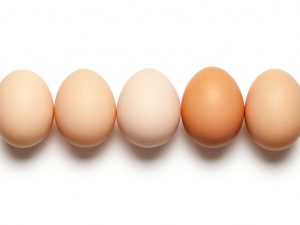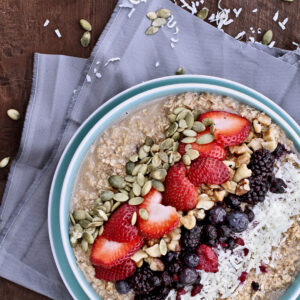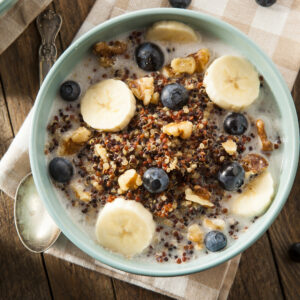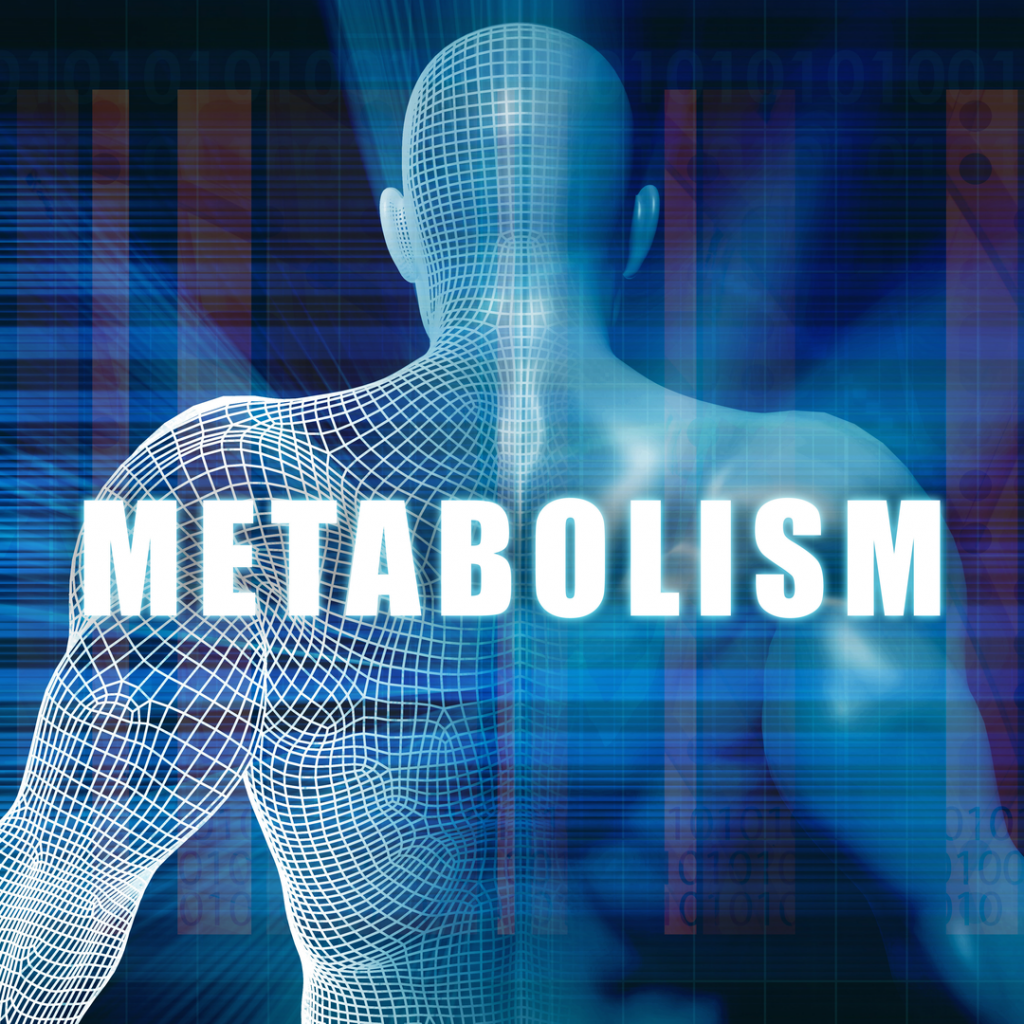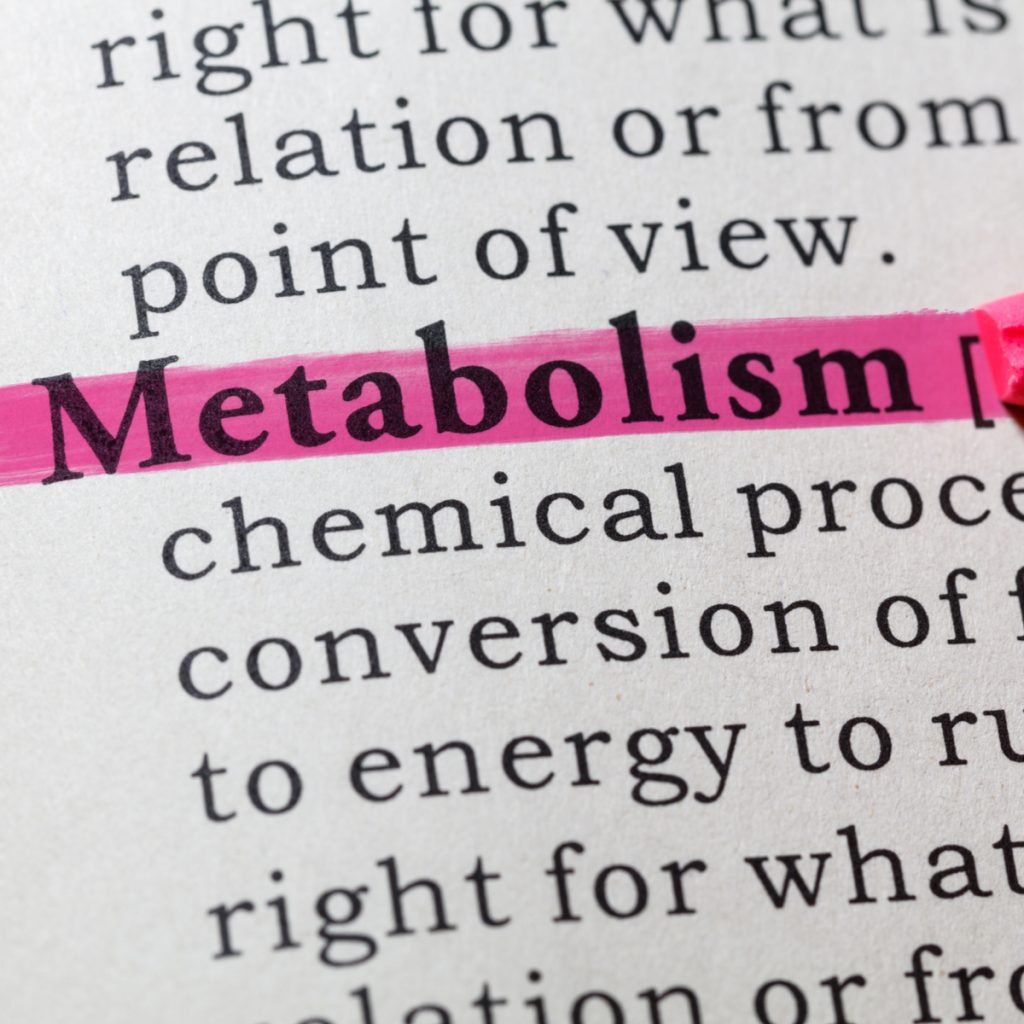Higher protein diets can help people lose weight, build and maintain muscle, energize metabolism, and feel fuller throughout the day, according to Dr. Donald K. Layman. Research by Dr. Layman and others has shown that protein at the first meal of the day is critical for maintaining metabolic health. For optimum benefit, adults need a minimum of 30g of protein at the first meal of the day. Keep your caloric intake between 250-350 calories. Fortunately, there are a variety of foods high in protein that people enjoy for breakfast, like eggs, yogurt, meats, cheese, tofu, and many more.
Breakfast is recognized as the most important meal for children and recent research has shown that the first meal is equally important for adults. For children the goal of breakfast is to fuel their rapidly growing bodies. For adults, the goal is to optimize muscle health and metabolism.
Protein needs for children and adults are different. Children have the advantage of hormones for growth; adults do not. For children, breakfast cereal with 5 g of protein and 40 g of carbohydrates may be okay but for adults, that’s a metabolic disaster. Too many carbs causing storage of body fat and too little protein to energize muscle. To optimize metabolic health, adults need a protein-to-carbohydrate ratio of about 1-to-1 which translates into 30 to 40 g of protein with no more than 40 g of carbs.
In the following article, you will learn why it is so important to plan your breakfast around protein and which foods are great sources of protein.
Why is protein important for breakfast?

Many people make the mistake of skipping breakfast or grabbing a donut or bagel and then getting all their protein later in the day. In the United States, most adults consume nearly 60% of their daily protein in a single meal after 6:00 in the evening … the dinner meal. This pattern of carbs for breakfast and protein for dinner is bad for metabolic health and associated with the obesity epidemic of modern societies.
Why is breakfast so important? There is plenty of research showing that breakfast meals high in protein aid in weight loss. Studies show that high protein foods can help reduce total daily food intake by regulating appetite. Proteins are the most filling, and can help you feel satisfied longer, plus they trigger an array of hormones in the intestine and in the brain to reduce hunger.
But beyond appetite regulation and helping you feel fuller for longer – getting the right amount of protein for breakfast will also jump-start your metabolism which increases your energy expenditure. This metabolic effect of protein originates in muscles associated with the important process of protein synthesis. Researchers call this the anabolic effect of meals. To fully appreciate the importance of breakfast, let’s review what’s going on with your metabolism when you wake up in the morning.
When the day begins, you likely have been fasting for nearly 12 hours. During this fasting period, the body is burning mostly stored fat to fuel your heart, lungs, brain, etc. These are calories we stored from previous meals. That’s all normal and good. We all have plenty of stored fat.
But our bodies handle protein totally different. To understand protein needs, we first need to understand the concept of protein turnover. Every protein in our bodies undergoes the processes of first being made (ie. synthesis) and then being replaced (ie. breakdown). The combination of synthesis and breakdown is called protein turnover. Some proteins, like liver enzymes, turnover every hour, while others, like collagen in tendons and bones, require months. But, in the big picture, essentially every protein in the body is replaced at least four times every year! This process of protein turnover determines a lot about your success with weight loss and ultimately your health during aging.
The body has a constant need for amino acids to support protein turnover. Organs like the brain, heart, kidney, intestines, and lungs have high rates of turnover even during the middle of the night while you’re sleeping and must have a constant supply of amino acids 24-hours per day. But unlike fat and carbohydrates, the body has no storage for amino acids, so during the nighttime fasting period, the body turns to the organ with the largest amount of protein, and that’s muscles. Our skeletal muscles contain nearly 50% of the amino acids in our bodies. During fasting periods, the body breaks down muscle proteins to provide amino acids for organs. Fasting is a catabolic period meaning a time when the body is breaking down proteins.
The balance between the anabolic periods after meals and the catabolic periods between meals determines a lot about metabolic health, success with weight loss, and healthy aging. The anabolic periods only occur after high protein meals and only last two to three hours.
Nearly 20 years ago, Dr. Layman’s research group discovered that the anabolic effect of a meal required a minimum of 30 g of protein and more specifically the protein needed to provide 3.0 g of the essential amino acid called leucine which is critical for muscle health. This discovery changed how we think about protein requirements and distribution at specific meals. Hence, both the amount of protein and the types of protein are important. Not all proteins are equal because they contain different amount of leucine.
Leucine plays a unique role that regulates muscle protein synthesis crucial to maintaining lean muscles and burning fat calories. As leucine circulates in the blood, it serves as a signal to muscles that the meal has adequate protein to support muscle protein synthesis. This creates the anabolic period. If the meal has less than 25 g of protein, and more important less than 3.0 g of leucine, the protein has no positive affect on muscle and basically becomes wasted calories.
Okay, that’s the science, let’s get back to breakfast.
At your first meal of the day, your muscles are catabolic and will remain catabolic breaking down muscle proteins until you consume a meal with at least 30 g of protein. If your only meal with 30 g is dinner, that means your body will be breaking down your metabolically active, calorie burning, lean tissues for at least 21 hours of the day, and only trying to recover during the 2 to 3-hour anabolic period after dinner. This pattern of meal distribution is why most weight loss diets fail. Research by Dr. Layman has shown that distributing protein into the first meals of the day is critical to protect lean healthy tissues and focus weight loss on body fat.
The science is clear, meals with adequate protein are best for increased weight loss, and the first meal of the day is critical. Luckily, there are a plethora of protein-rich breakfast foods available, hitting the ideal amount of protein should be no trouble at all!
Protein foods for breakfast
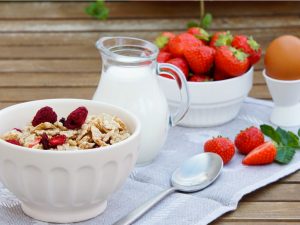
Below is a list of foods typically associated with breakfast that are packed with protein to keep your hunger at bay and energize your muscles! To reach the ideal 30-35 grams of protein for breakfast, it’s usually necessary to mix and match some of these foods to make tasty and healthy meals. Don’t be afraid to use a high protein leftover from dinner. Shrimp cocktail, chicken and vegetable stir-fry, or chili can be just as good for your first meal as your last meal.
Some of our favorite high protein breakfast foods include:
- Eggs (6.5 g per large egg)
- Milk (1 g per ounce)
- Greek yogurt (7 g per ½ cup)
- Cottage cheese (14 g per ½ cup)
- Kefir (8 g per 8 ounces)
- Ham or Canadian bacon (7 g per ounce)
- Chicken or turkey sausage (7 g per ounce)
- Cheese (5 g per ounce)
- Bacon (8 g per ounce, cooked; 2 to 3 g per slice)
- Protein shake (approximately 20 g per scoop; check the label)
- Tofu (4 g per ounce; 16 g per ½ cup)
- Smoked salmon (7 g per ounce)
- Black beans (7.5 g per ½ cup)
- Oatmeal (6 g per cup)
- Peanut butter (7 g per 2 Tbs)
- Quinoa (9 g per cup; cooked)
- Keto breads
Creating an anabolic breakfast
An anabolic breakfast requires adequate protein but also protein with 3.0 g of the amino acid leucine. A whey protein powder can be used to create a breakfast shake with only 25 g of protein that provides 3.0 g of leucine, but a soy protein powder requires more than 37 g of protein to create a shake with 3.0 g of leucine. All proteins are not equal and when you use plant-based proteins you always need more total protein. Beware, plant protein meals often contain more carbs and more calories. Remember, for weight loss, you need to create a 1-to-1 balance of protein to carbohydrates in your meal.
Below are some great combinations to use for a protein-packed breakfast … but use these foods for any meal.
Eggs
One of the best high-protein breakfast foods is already a favorite around the world. Eggs are inexpensive and can be prepared in many different ways. Two large eggs contain 13 grams of protein. You can hard boil them ahead of time for an easy grab-and-go breakfast, or cook them into omelets, scrambles, or frittatas for a delicious hot meal. Add some cheese, lean ham, or a glass of milk to help you reach your 30 g target.
One of the favorite meal combinations at our weight loss center, was a takeoff on the egg sandwich popular at fast-food restaurants. Take two sandwiches and discard ½ of the bread from each sandwich. As an example, 2 eggs (13 g of protein), 2 oz of Canadian bacon or ham (14 g), 1 slice American cheese (4 g) and an English muffin (5 g). That’s a total of 37 g of protein and 3.1 g of leucine. You can create this sandwich at home or at almost any restaurant. If you like, you can substitute a glass of milk for some of the ham, egg, or cheese to suit you tastes.
One more example, 2 eggs over-easy (13 g), 4 slices of bacon (8 g), 1 slice of whole wheat toast (5 g), and 2 Tbs of peanut butter (7 g). That’s a total of 33 g of protein.
Greek Yogurt, Kefir and Protein Powder
Greek yogurt and Kefir are lower in carbohydrates and higher in protein than other types of yogurts due to how they are made. Combine the yogurt, Kefir, and blend in some protein powder and berries for a quick on-the-go shake for breakfasts. Greek yogurt can also be mixed with other protein foods like nuts or seeds and enjoyed as a parfait.
Oatmeal
Oatmeal is one of the few cereal grains that you can use. Oatmeal has a low glycemic index (that means it keeps your insulin under control) and high fiber, but it needs to be combined with high-protein foods like protein powder, Greek yogurt, milk, nuts, or seeds. Our favorite combination is 1 cup cooked oatmeal (5 g of protein), cooked in 8 oz of milk (8 g), after oatmeal is prepared mix in 1 scoop of protein powder (20 g) and add ¼ cup chopped pecan (3 g) or sliced almonds (5 g). That’s a total of 36 g of protein.
Other options with oatmeal to get your total protein is to add chicken or turkey sausage to the meal. These sausages are low in carbs and fat and provide around 14 g of protein in each 2 oz serving.
Also remember, adding a glass of milk is a great way to add extra high-quality protein to any meal. Milk contains about 8 grams of protein per cup.
Milk
Milk is a great morning beverage to add a protein boost. It can also be added to smoothies or served with protein-packed granola that contains lots of nuts and seeds. Milk contains about 8 grams of protein per cup.
Chicken or turkey sausages
Chicken and turkey sausages are some of our favorites because they pack a lean mean protein punch, while also keeping calories low in comparison to other sausages. They are also lower in fats. Eat them on their own, or cook them into other dishes, or serve them as a side with eggs and whole-wheat toast. They contain around 14 grams of protein in each 2 oz serving.
Bacon
Everything is better with bacon. The flavor is unbeatable, luckily it is also high in protein and low in carbs. Two slices of bacon have 4-7 grams of protein on average with less than a gram of carbs and 60 -80 calories. Bacon is often a great addition to any breakfast meal to ensure you reach the 30g goal.
Quinoa
Quinoa is a popular pseudo-cereal that many consider a superfood. It’s rich in vitamins, minerals, fiber, and antioxidants. One cup of cooked quinoa has 9 grams of protein
Quinoa can be used to create a great breakfast bowl. Cook the quinoa in soy milk to add protein. Throw in whatever veggies sound good or try adding peanut butter for extra protein. But, quinoa has only about 9 g of protein per cup once cooked, so remember, your protein target for breakfast is 30 g. You may still need to add chicken sausage or scrambled eggs to create your anabolic breakfast.
Protein Shake
There is no lack of options on the market when it comes to protein shakes. Shakes make one of the fastest, easiest, tastiest, and most portable food options, which makes them a staple among those looking for protein foods for breakfast, but not all are created equally. Be on the lookout for a shake the delivers at least 30 g of protein if you plan to make it with water, delivers some fat and carbs to make if a full meal replacement and comes in 200-300 total calories. Try out our MetabolicTM Shake created specifically as a meal replacement for our Metabolic Lifestyle.
Cottage cheese
Like Greek yogurt, cottage cheese is an awesome choice for mornings when you need something quick and easy. It can also be used as an ingredient in a variety of breakfast recipes or eaten alongside fruit or grains. It contains 14 grams of protein per ½ cup!
Black beans
Black beans are a delicious and unique way to add more protein to your breakfasts. They taste great added into an omelet, scramble, or even prepared in a breakfast quesadilla. You can boil them ahead of time to use throughout the week, or even purchase them canned for added convenience. In each cup of black beans, there are 15 grams of protein!
Tofu
If you’re a vegetarian, it can be difficult to get enough protein, but the truth is there are a variety of options for non-meat eaters and tofu is one of the best. It’s super easy to prepare into a tasty scramble with spices or combined with other high-protein ingredients like black beans.
A ½ cup serving of tofu contains about 16 grams of protein.
A tofu scramble with spinach is a perfect breakfast option for vegetarians who want an egg-like breakfast dish. Sauté 1 diced tomato, 1 garlic, and mushrooms in 1 Tbs olive oil; then add spinach and ½ pound (8 oz) of crumbed tofu (32 g protein); cover and cook for 5 to 7 minutes.
Black beans are a delicious and unique way to add more protein to your breakfast. They taste great added into an omelet, scramble, or even prepared in a breakfast quesadilla. You can boil them ahead of time to use throughout the week, or even purchase them canned for added convenience. In each cup of black beans, there are 15 grams of protein!
Smoked Salmon
Have you ever enjoyed a delicious lox bagel for breakfast? While we might suggest skipping out on the carb-heavy bagel, smoked salmon is an excellent source of protein. Pair it with eggs and asparagus for a breakfast that feels fancy and is super healthy. In each 3 oz serving of smoked salmon, there are about 20 grams of protein.
Keto Fathead Bread
Breads are hard to come by when you’re trying to eat high protein, lower carb, but Keto Flathead bread is a great alternative that is great for breakfast sandwiches, toast, bagels, breakfast pizzas and even breakfast rolls. You should be able to find keto breads with about 13 g of protein and just 4 g of carbs per serving. The keto breads can be used in combination with eggs or meats to get your 30 g of protein.

